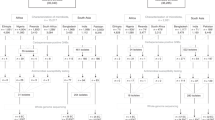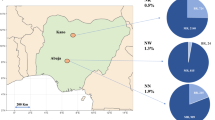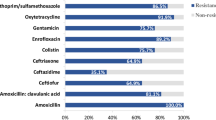Abstract
Objective:
To study (i) the prevalence and risk factors for carriage of extended-spectrum β-lactamase-producing Enterobacteriaceae (ESBL-E) in pregnant women, (ii) the maternal–neonatal transmission rate of ESBL-E at birth and (iii) the prevalence of ESBL-E in expressed breast milk of colonized mothers.
Study design:
In this cross-sectional, population-based study with case follow-up on maternal–neonatal transmission of ESBL-E, women were screened for rectal ESBL-E colonization at 36 weeks of pregnancy and delivery. Possible risk factors for colonization were studied by logistic regression. Infants of ESBL-E-positive mothers were screened for ESBL-E during their first weeks of life. ESBL-encoding genes were detected by PCR and clonal relatedness was investigated by pulsed-field gel electrophoreses.
Results:
In total, 26 out of 901 (2.9%) women were colonized by ESBL-producing Escherichia coli at 36 weeks of pregnancy. One of the women carried an additional ESBL Klebsiella pneumoniae strain. Adjusted for traveling, African or Asian nationality was a risk factor for colonization; OR=5.62 (2.21, 14.27) (LR-p=0.003). Fourteen women remained ESBL-E carriers at delivery. ESBL-E strains indistinguishable from the strains isolated from their respective mothers were detected in 5 (35.7%) infants during their first days of life (median day 3; range=2 to 8). A total of 146 expressed milk samples were cultured from 25 out of 26 colonized mothers, all were ESBL-E negative.
Conclusions:
The prevalence of ESBL-E carriage among pregnant women was low in our region, but the high maternal–neonatal transmission rate suggests that colonized mothers represent a substantial risk for infant colonization.
This is a preview of subscription content, access via your institution
Access options
Subscribe to this journal
Receive 12 print issues and online access
$259.00 per year
only $21.58 per issue
Buy this article
- Purchase on Springer Link
- Instant access to full article PDF
Prices may be subject to local taxes which are calculated during checkout


Similar content being viewed by others
References
Abdel-Hady H, Hawas S, El-Daker M, El-Kady R . Extended-spectrum beta-lactamase producing Klebsiella pneumoniae in neonatal intensive care unit. J Perinatol 2008; 28: 685–690.
Rettedal S, Lohr IH, Natas O, Giske CG, Sundsfjord A, Oymar K . First outbreak of extended-spectrum beta-lactamase-producing Klebsiella pneumoniae in a Norwegian neonatal intensive care unit; associated with contaminated breast milk and resolved by strict cohorting. APMIS 2012; 120: 612–621.
Stone PW, Gupta A, Loughrey M, Della-Latta P, Cimiotti J, Larson E et al. Attributable costs and length of stay of an extended-spectrum beta-lactamase-producing Klebsiella pneumoniae outbreak in a neonatal intensive care unit. Infect Control Hosp Epidemiol 2003; 24: 601–606.
Cantey JB, Sreeramoju P, Jaleel M, Trevino S, Gander R, Hynan LS et al. Prompt control of an outbreak caused by extended-spectrum beta-lactamase-producing Klebsiella pneumoniae in a neonatal intensive care unit. J Pediatr 2013; 163: e671–e673.
Woerther PL, Burdet C, Chachaty E, Andremont A . Trends in human fecal carriage of extended-spectrum beta-lactamases in the community: toward the globalization of CTX-M. Clin Microbiol Rev 2013; 26: 744–758.
Denkel LA, Schwab F, Kola A, Leistner R, Garten L, von Weizsacker K et al. The mother as most important risk factor for colonization of very low birth weight (VLBW) infants with extended-spectrum beta-lactamase-producing Enterobacteriaceae (ESBL-E). J Antimicrob Chemother 2014; 69: 2230–2237.
Dubois V, De Barbeyrac B, Rogues AM, Arpin C, Coulange L, Andre C et al. CTX-M-producing Escherichia coli in a maternity ward: a likely community importation and evidence of mother-to-neonate transmission. J Antimicrob Chemother 2010; 65: 1368–1371.
Tschudin-Sutter S, Frei R, Battegay M, Hoesli I, Widmer AF . Extended spectrum ss-lactamase-producing Escherichia coli in neonatal care unit. Emerg Infect Dis 2010; 16: 1758–1760.
Seale J, Millar M . Perinatal vertical transmission of antibiotic-resistant bacteria: a systematic review and proposed research strategy. BJOG 2014; 121: 923–928.
Cipolla D, Giuffre M, Mammina C, Corsello G . Prevention of nosocomial infections and surveillance of emerging resistances in NICU. J Matern Fetal Neonatal Med 2011; 24: 23–26.
Benenson S, Levin PD, Block C, Adler A, Ergaz Z, Peleg O et al. Continuous surveillance to reduce extended-spectrum beta-lactamase Klebsiella pneumoniae colonization in the neonatal intensive care unit. Neonatology 2013; 103: 155–160.
Rybczynska H, Melander E, Johansson H, Lundberg F . Efficacy of a once-a-week screening programme to control extended-spectrum beta-lactamase-producing bacteria in a neonatal intensive care unit. Scand J Infect Dis 2014; 46: 426–432.
Giske CG, Sundsfjord AS, Kahlmeter G, Woodford N, Nordmann P, Paterson DL et al. Redefining extended-spectrum beta-lactamases: balancing science and clinical need. J Antimicrob Chemother 2009; 63: 1–4.
Testing ECoAS. Clinical breakpoint tables version 2.0. 2012 [cited]. Available at http://www.eucast.org.
Birkett CI, Ludlam HA, Woodford N, Brown DF, Brown NM, Roberts MT et al. Real-time TaqMan PCR for rapid detection and typing of genes encoding CTX-M extended-spectrum beta-lactamases. J Med Microbiol 2007; 56: 52–55.
Sundsfjord A, Simonsen GS, Haldorsen BC, Haaheim H, Hjelmevoll SO, Littauer P et al. Genetic methods for detection of antimicrobial resistance. APMIS 2004; 112: 815–837.
Brolund A, Wisell KT, Edquist PJ, Elfstrom L, Walder M, Giske CG . Development of a real-time SYBRGreen PCR assay for rapid detection of acquired AmpC in Enterobacteriaceae. J Microbiol Methods 2010; 82: 229–233.
Standard Operating Procedure for PulseNet PFGE of Escherichia coli O157:H7, Escherichia coli non-O157 (STEC), Salmonella serotypes, Shigella sonnei and Shigella flexneri. [cited].Available at http://www.cdc.gov/pulsenet/PDF/ecoli-shigella-salmonella-pfge-protocol-508c.pdf.
Tenover FC, Arbeit RD, Goering RV, Mickelsen PA, Murray BE, Persing DH et al. Interpreting chromosomal DNA restriction patterns produced by pulsed-field gel electrophoresis: criteria for bacterial strain typing. J Clin Microbiol 1995; 33: 2233–2239.
NORM/NORM-VET 2013 Usage of Antimicrobial Agents and Occurrence of Antimicrobial Resistance in Norway. Tromsø: Oslo, 2014.
Hansen DS, Schumacher H, Hansen F, Stegger M, Hertz FB, Schonning K et al. Extended-spectrum beta-lactamase (ESBL) in Danish clinical isolates of Escherichia coli and Klebsiella pneumoniae: prevalence, beta-lactamase distribution, phylogroups, and co-resistance. Scand J Infect Dis 2012; 44: 174–181.
Brolund A, Edquist PJ, Makitalo B, Olsson-Liljequist B, Soderblom T, Wisell KT et al. Epidemiology of extended-spectrum beta-lactamase-producing Escherichia coli in Sweden 2007-2011. Clin Microbiol Infect 2014; 20: O344–O352.
Ostholm-Balkhed A, Tarnberg M, Nilsson M, Nilsson LE, Hanberger H, Hallgren A et al. Travel-associated faecal colonization with ESBL-producing Enterobacteriaceae: incidence and risk factors. J Antimicrob Chemother 2013; 68: 2144–2153.
Pathak A, Chandran SP, Mahadik K, Macaden R, Lundborg CS . Frequency and factors associated with carriage of multi-drug resistant commensal Escherichia coli among women attending antenatal clinics in central India. BMC Infect Dis 2013; 13: 199.
Villar HE, Aubert V, Baserni MN, Jugo MB . Maternal carriage of extended-spectrum beta-lactamase-producing Escherichia coli isolates in Argentina. J Chemother 2013; 25: 324–327.
Lopez-Cerero L, Jiménez C, Luna S, Vera C, Rodríguez-Baño J, Pascual A Prevalence of ESBLproducing Enterobacteriaceae; mother colonization and mother-to-neonate transmission. ECCMID Conference, Barcelona, 2014.
Wickramasinghe NH, Xu L, Eustace A, Shabir S, Saluja T, Hawkey PM . High community faecal carriage rates of CTX-M ESBL-producing Escherichia coli in a specific population group in Birmingham, UK. J Antimicrob Chemother 2012; 67: 1108–1113.
Lohr IH, Rettedal S, Natas OB, Naseer U, Oymar K, Sundsfjord A . Long-term faecal carriage in infants and intra-household transmission of CTX-M-15-producing Klebsiella pneumoniae following a nosocomial outbreak. J Antimicrob Chemother 2013; 68: 1043–1048.
Valverde A, Grill F, Coque TM, Pintado V, Baquero F, Canton R et al. High rate of intestinal colonization with extended-spectrum-beta-lactamase-producing organisms in household contacts of infected community patients. J Clin Microbiol 2008; 46: 2796–2799.
Rodriguez-Bano J, Lopez-Cerero L, Navarro MD, Diaz de Alba P, Pascual A . Faecal carriage of extended-spectrum beta-lactamase-producing Escherichia coli: prevalence, risk factors and molecular epidemiology. J Antimicrob Chemother 2008; 62: 1142–1149.
Leistner R, Meyer E, Gastmeier P, Pfeifer Y, Eller C, Dem P et al. Risk factors associated with the community-acquired colonization of extended-spectrum beta-lactamase (ESBL) positive Escherichia Coli. an exploratory case-control study. PLoS One 2013; 8: e74323.
Lausch KR, Fuursted K, Larsen CS, Storgaard M . Colonisation with multi-resistant Enterobacteriaceae in hospitalised Danish patients with a history of recent travel: a cross-sectional study. Travel Med Infect Dis 2013; 11: 320–323.
Tangden T, Cars O, Melhus A, Lowdin E . Foreign travel is a major risk factor for colonization with Escherichia coli producing CTX-M-type extended-spectrum beta-lactamases: a prospective study with Swedish volunteers. Antimicrob Agents Chemother 2010; 54: 3564–3568.
Laupland KB, Church DL, Vidakovich J, Mucenski M, Pitout JD . Community-onset extended-spectrum beta-lactamase (ESBL) producing Escherichia coli: importance of international travel. J Infect 2008; 57: 441–448.
Tham J, Odenholt I, Walder M, Brolund A, Ahl J, Melander E . Extended-spectrum beta-lactamase-producing Escherichia coli in patients with travellers' diarrhoea. Scand J Infect Dis 2010; 42: 275–280.
Peirano G, Laupland KB, Gregson DB, Pitout JD . Colonization of returning travelers with CTX-M-producing Escherichia coli. J Travel Med 2011; 18: 299–303.
Kennedy K, Collignon P . Colonisation with Escherichia coli resistant to "critically important" antibiotics: a high risk for international travellers. Eur J Clin Microbiol Infect Dis 2010; 29: 1501–1506.
Rogers BA, Kennedy KJ, Sidjabat HE, Jones M, Collignon P, Paterson DL . Prolonged carriage of resistant E. coli by returned travellers: clonality, risk factors and bacterial characteristics. Eur J Clin Microbiol Infect Dis 2012; 31: 2413–2420.
Tumbarello M, Trecarichi EM, Bassetti M, De Rosa FG, Spanu T, Di Meco E et al. Identifying patients harboring extended-spectrum-beta-lactamase-producing Enterobacteriaceae on hospital admission: derivation and validation of a scoring system. Antimicrob Agents Chemother 2011; 55: 3485–3490.
Soraas A, Sundsfjord A, Sandven I, Brunborg C, Jenum PA . Risk factors for community-acquired urinary tract infections caused by ESBL-producing enterobacteriaceae—a case-control study in a low prevalence country. PLoS One 2013; 8: e69581.
Ben-Ami R, Rodriguez-Bano J, Arslan H, Pitout JD, Quentin C, Calbo ES et al. A multinational survey of risk factors for infection with extended-spectrum beta-lactamase-producing enterobacteriaceae in nonhospitalized patients. Clin Infect Dis 2009; 49: 682–690.
Datta N, Faiers MC, Reeves DS, Brumfitt W, Orskov F, Orskov I R . Factors in Escherichia coli in faeces after oral chemotherapy in general practice. Lancet 1971; 1: 312–315.
Dominguez-Bello MG, Costello EK, Contreras M, Magris M, Hidalgo G, Fierer N et al. Delivery mode shapes the acquisition and structure of the initial microbiota across multiple body habitats in newborns. Proc Natl Acad Sci U S A 2010; 107: 11971–11975.
Birgy A, Mariani-Kurkdjian P, Bidet P, Doit C, Genel N, Courroux C et al. Characterization of extended-spectrum-beta-lactamase-producing Escherichia coli strains involved in maternal-fetal colonization: prevalence of E. coli ST131. J Clin Microbiol 2013; 51: 1727–1732.
Strenger V, Feierl G, Resch B, Zarfel G, Grisold A, Masoud-Landgraf L et al. Fecal carriage and intrafamilial spread of extended-spectrum beta-lactamase-producing enterobacteriaceae following colonization at the neonatal ICU. Pediatr Crit Care Med 2013; 14: 157–163.
Acknowledgements
We thank all of the participating pregnant women and infants; all the midwives at the Department of Obstetrics, Stavanger University Hospital, especially Liv Ingunn Nevland, for recruiting the participants, secretary Wenche Digranes at the Pediatric Department, Stavanger University Hospital, Ragnhild Omholt and Kirsti Gummedal at the Department of Medical Microbiology, Stavanger University Hospital, biostatistician Geir Egil Eide, Centre for Clinical Research, Haukeland University Hospital, Bergen, and the Norwegian Reference Center for Detection of Antimicrobial Resistance, University Hospital of North Norway, for their support. This work was partly funded by a grant from NORM surveillance program for antimicrobial resistance in human pathogens.
Author information
Authors and Affiliations
Corresponding author
Ethics declarations
Competing interests
The authors declare no conflict of interest.
Additional information
This work was presented as a poster at the 31st Annual Meeting of the Nordic Society of Clinical Microbiology and Infectious Diseases, Bergen, Norway 2014.
Supplementary Information accompanies the paper on the Journal of Perinatology website .
Supplementary information
Rights and permissions
About this article
Cite this article
Rettedal, S., Löhr, I., Bernhoff, E. et al. Extended-spectrum β-lactamase-producing Enterobacteriaceae among pregnant women in Norway: prevalence and maternal–neonatal transmission. J Perinatol 35, 907–912 (2015). https://doi.org/10.1038/jp.2015.82
Received:
Revised:
Accepted:
Published:
Issue Date:
DOI: https://doi.org/10.1038/jp.2015.82
This article is cited by
-
Vaginal colonization with antimicrobial-resistant bacteria among women in labor in central Uganda: prevalence and associated factors
Antimicrobial Resistance & Infection Control (2021)
-
A systematic review and meta-analysis on the prevalence of Escherichia coli and extended-spectrum β-lactamase-producing Escherichia coli in pregnant women
Archives of Gynecology and Obstetrics (2021)
-
Multi-drug resistant and extended-spectrum β-lactamases producing bacterial uropathogens among pregnant women in Northwest Ethiopia
Annals of Clinical Microbiology and Antimicrobials (2020)
-
Fecal carriage and factors associated with extended-spectrum β-lactamase-producing Enterobacteriaceae among pregnant women at the tertiary referral hospital, Tanzania
Tropical Medicine and Health (2020)
-
Extended-spectrum beta-lactamase (ESBL) producing Enterobacterales in stool surveillance cultures of preterm infants are no risk factor for necrotizing enterocolitis: a retrospective case–control study over 12 years
Infection (2020)



